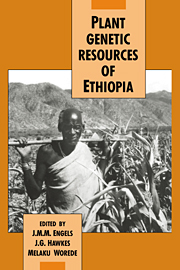Book contents
- Frontmatter
- Contents
- Contributors
- List of acronyms
- Preface
- Part I General introduction
- Part II The Ethiopian centre of diversity
- Part III Germplasm collection and conservation in Ethiopia
- Part IV Evaluation and utilization of Ethiopian genetic resources
- 18 Germplasm evaluation with special reference to the role of taxonomy in genebanks
- 19 Crop germplasm multiplication, characterization, evaluation and utilization at PGRC/E
- 20 Evaluation methods and utilization of germplasm of annual crop species
- 21 Evaluation and utilization of Ethiopian forage species
- 22 Improvement of indigenous durum wheat landraces in Ethiopia
- 23 Use of germplasm resources in breeding wheat for disease resistance
- 24 Indigenous barley germplasm in the Ethiopian breeding programme
- 25 The role of Ethiopian sorghum germplasm resources in the national breeding programme
- 26 Germplasm evaluation and breeding work on teff (Eragrostis tef) in Ethiopia
- 27 Pulse crops of Ethiopia: genetic resources and their utilization
- 28 Oil crop germplasm: a vital resource for the plant breeder
- 29 Significance of Ethiopian coffee genetic resources to coffee improvement
- 30 Use of Ethiopian germplasm in national and international programmes
- Index
22 - Improvement of indigenous durum wheat landraces in Ethiopia
Published online by Cambridge University Press: 30 October 2009
- Frontmatter
- Contents
- Contributors
- List of acronyms
- Preface
- Part I General introduction
- Part II The Ethiopian centre of diversity
- Part III Germplasm collection and conservation in Ethiopia
- Part IV Evaluation and utilization of Ethiopian genetic resources
- 18 Germplasm evaluation with special reference to the role of taxonomy in genebanks
- 19 Crop germplasm multiplication, characterization, evaluation and utilization at PGRC/E
- 20 Evaluation methods and utilization of germplasm of annual crop species
- 21 Evaluation and utilization of Ethiopian forage species
- 22 Improvement of indigenous durum wheat landraces in Ethiopia
- 23 Use of germplasm resources in breeding wheat for disease resistance
- 24 Indigenous barley germplasm in the Ethiopian breeding programme
- 25 The role of Ethiopian sorghum germplasm resources in the national breeding programme
- 26 Germplasm evaluation and breeding work on teff (Eragrostis tef) in Ethiopia
- 27 Pulse crops of Ethiopia: genetic resources and their utilization
- 28 Oil crop germplasm: a vital resource for the plant breeder
- 29 Significance of Ethiopian coffee genetic resources to coffee improvement
- 30 Use of Ethiopian germplasm in national and international programmes
- Index
Summary
Importance of wheat in Ethiopia
Wheat has been and continues to be one of the most important cereal crops in Ethiopia in terms of both area under cultivation and production. In 1983, the area under wheat production was estimated at 625 590 ha with an average production of 1065 kg/ha (Central Statistics Office, 1984). The demand for wheat as a staple food grain is increasing, especially in the urban areas, while its utilization will be high even in the rural sector in the near future. At present, consumer demand for wheat as a staple food grain is increasing, especially in the urban areas, while its utilization will be high even in the rural sector in the near future. At present, consumer demand far exceeds domestic production and wheat imports are costing the country millions of dollars in foreign exchange. Wheat constitutes a large portion of the daily diet of the population and contributes significantly to the calorie and protein intake. It is consumed in several different forms such as leavened bread, pancakes, macaroni and spaghetti, biscuits and pastries. The most common of the Ethiopian recipes are dabo (Ethiopian home-made bread), hambasha (home-made bread from northern Ethiopia), kitta (unleavened bread), injera (thin bread, part of the national dish and prepared mainly from teff), nifro (boiled whole grains, sometimes mixed with pulses), kolo (roasted whole grains), dabo-kollo (ground and seasoned dough, shaped and deep fried) and kinche (crushed kernels, cooked with milk or water and mixed with spiced butter).
- Type
- Chapter
- Information
- Plant Genetic Resources of Ethiopia , pp. 288 - 295Publisher: Cambridge University PressPrint publication year: 1991
- 9
- Cited by



